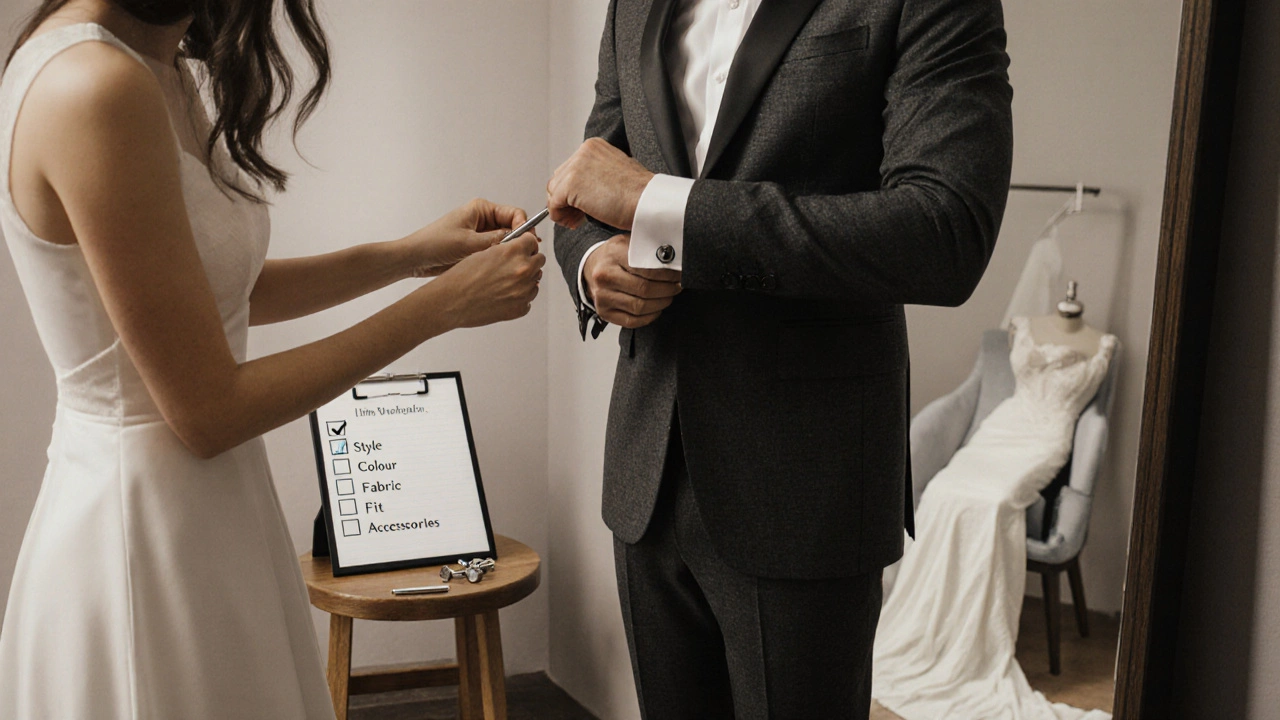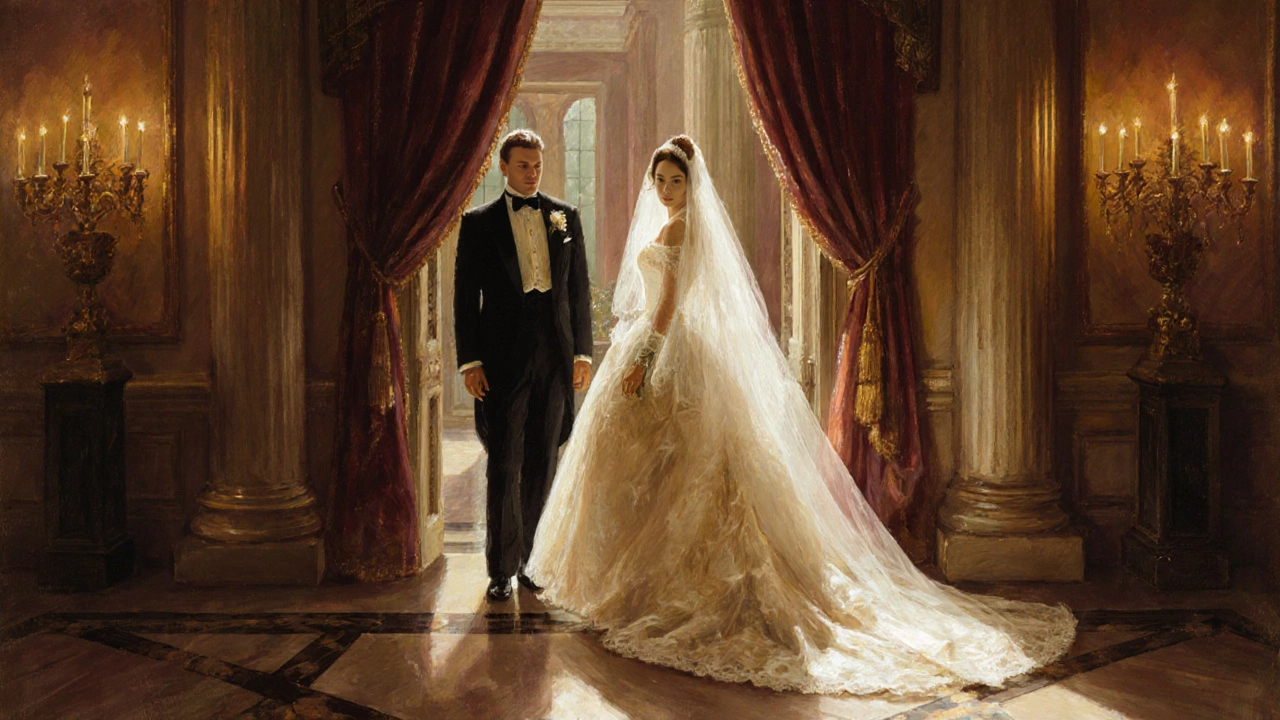Groom's Suit Planning Guide
Plan your suit reveal with this step-by-step timeline:
| Item | What to Confirm | Why It Matters |
|---|---|---|
| Style | tuxedo, classic suit, modern slim fit | Sets the formality level |
| Colour | navy, charcoal, black, or a hue from the wedding palette | Ensures visual harmony with the bride’s dress and décor |
| Fabric | wool, wool-blend, linen (season-appropriate) | Comfort and drape in the venue’s climate |
| Fit | shoulders, chest, sleeve length, trouser break | A well-fitted suit looks sharp on photos |
| Accessories | shoes, belt, cufflinks, pocket square, boutonnière | Details tie the look to the overall theme |
| Coordination | match the bride’s dress style and the wedding colour scheme | Creates a cohesive visual story |
| Timeline | schedule fittings, allow for alterations | Avoid last-minute stress |
How Much Should You Reveal?
Answer these questions to determine your approach:
Your Recommended Approach:
- Assuming the bride knows your taste
- Neglecting venue climate
- Skipping the final fitting
- Not involving the photographer
- Ignoring cultural traditions
Key Takeaways
- Traditional etiquette usually keeps the groom’s suit a surprise, but modern couples often share details early.
- Open communication prevents mismatched expectations about colour, style and accessories.
- A simple timeline - discuss the look, share photos, schedule a fitting - works for most couples.
- Use the checklist below to make sure the suit fits the wedding theme and the bride’s dress.
- Common pitfalls include assuming the other partner knows your taste and neglecting practical fit issues.
When you’re deep in wedding planning, a tiny detail like the groom’s suit can feel surprisingly big. The question pops up a lot: Are brides allowed to see the groom’s suit? The answer isn’t a simple yes or no - it depends on tradition, personal style, and how much you want the two looks to sync.
Groom's suit is a formal outfit worn by the husband‑to‑be on the wedding day, ranging from classic tuxedos to modern slim‑fit suits. It’s one of the most visible pieces of the ceremony, yet many couples treat it like a secret project.
1. The historical backdrop - why secrecy mattered
In the Victorian era, a groom’s attire was part of the ceremony’s surprise. The bride would enter the venue, see the groom for the first time in his full regalia, and experience that moment of awe. That tradition fed the idea that the bride should not see the suit before the wedding.
Fast‑forward to the 1950s and 60s, and the rule stayed alive in many cultures: the groom’s men would dress in a coordinated look, and the bride’s friends would keep the details under wraps. The notion was less about control and more about preserving the emotional impact of the first look.

2. Modern shifts - from secrecy to transparency
Today, couples tend to be more collaborative. Instagram, Pinterest and virtual try‑on apps let couples share style boards instantly. A 2023 survey by WeddingWire (based on 2,500 engaged couples) found that 68% of brides liked to see at least a photo of the groom’s suit before the big day.
Why the change?
- Wedding etiquette has become less rigid, focusing on mutual respect rather than tradition for tradition’s sake.
- Coordinated colour palettes improve the visual flow of ceremony photos.
- Early visibility helps avoid costly last‑minute alterations.
3. How to decide what works for you
The first step is a candid conversation. Sit down with your partner and ask questions like:
- Do you want the suit to match the wedding theme?
- Are you comfortable sharing a photo before the final fitting?
- Do you prefer a formal tuxedo or a more relaxed suit?
Answering these questions clarifies expectations and sets the stage for a smooth planning process.
4. Practical timeline for the suit reveal
Here’s a simple schedule that works for most couples planning a 2025 wedding:
- Month 8-9 before the wedding: Choose the style (tuxedo, two‑piece suit, morning suit) and colour. Share a mood board with your bride.
- Month 6-7: Book a reputable tailor for measurements.
- Month 5: Send a photo of the chosen jacket and trousers to the bride. Ask for her thoughts on fit with the dress silhouette.
- Month 3-4: Schedule a fitting with the tailor. Invite the bride (or a trusted bridesmaid) to see the suit in person.
- Month 2: Final adjustments. Confirm accessories like cufflinks, pocket squares, and shoes.
- Week of the wedding: Do a quick mirror check. Take a full‑body photo for the photographer’s reference.

5. Checklist - making sure the suit matches the whole wedding
| Item | What to Confirm | Why It Matters |
|---|---|---|
| Style | tuxedo, classic suit, modern slim fit | Sets the formality level |
| Colour | navy, charcoal, black, or a hue from the wedding palette | Ensures visual harmony with the bride’s dress and décor |
| Fabric | wool, wool‑blend, linen (season‑appropriate) | Comfort and drape in the venue’s climate |
| Fit | shoulders, chest, sleeve length, trouser break | A well‑fitted suit looks sharp on photos |
| Accessories | shoes, belt, cufflinks, pocket square, boutonnière | Details tie the look to the overall theme |
| Coordination | match the bride’s dress style and the wedding colour scheme | Creates a cohesive visual story |
| Timeline | schedule fittings, allow for alterations | Avoid last‑minute stress |
6. Common pitfalls and how to avoid them
Assuming the bride knows your taste. Even if you’ve talked about colours, the exact cut can change the vibe. Share photos early.
Neglecting the venue’s climate. A heavy wool tuxedo in a summer beach wedding leads to discomfort. Choose appropriate fabric.
Skipping the final fitting. Last‑minute tailoring can ruin the silhouette and cause delays for the photographer’s schedule.
Speaking of photographers, wedding photographer often recommends a suit that photographs well under the lighting conditions you’ll use. Ask them for input during the fitting stage.
7. Frequently Asked Questions
Should the bride see the full suit or just a sample?
Is a full‑suit preview necessary?
Most couples find a photo of the jacket and trousers sufficient. A full‑body try‑on is helpful if the bride wants to check how the suit pairs with her dress silhouette. The key is open communication, not the level of detail.
Can the groom wear a suit that doesn't match the colour palette?
He can, but it may clash with the overall aesthetic. If the bride’s dress is ivory and the décor is pastel, a stark black tuxedo can still work for a formal vibe. However, a navy or charcoal suit often blends more smoothly while keeping a formal feel.
When is the best time to involve the bride in suit fittings?
Ideally after the first measurement but before the final alteration. This gives both partners a chance to see the fit and make minor tweaks without committing to costly changes.
Do cultural traditions still dictate suit secrecy?
Some cultures, like certain Indian or Middle‑Eastern traditions, still value a surprise element. In those cases, the groom may reveal the attire only on the wedding day while respecting family customs.
How can a couple keep the suit a surprise yet ensure it matches?
Share a colour swatch or fabric sample without showing the full design. This lets the bride approve the palette while keeping the exact cut under wraps.
Whether you choose to keep the suit a secret or reveal it early, the most important thing is that both partners feel confident and comfortable. A well‑coordinated look makes photos pop, reduces stress, and lets you focus on the celebration rather than the outfit.
In short, there’s no hard rule that says a bride can’t see the groom’s suit. The decision rests on personal preference, cultural background, and how much coordination you want for the big day. Use the checklist, communicate openly, and you’ll both step into the wedding looking sharp and synced.

